West
California man allegedly robbed bank, took hostages day after release from state prison: DOJ
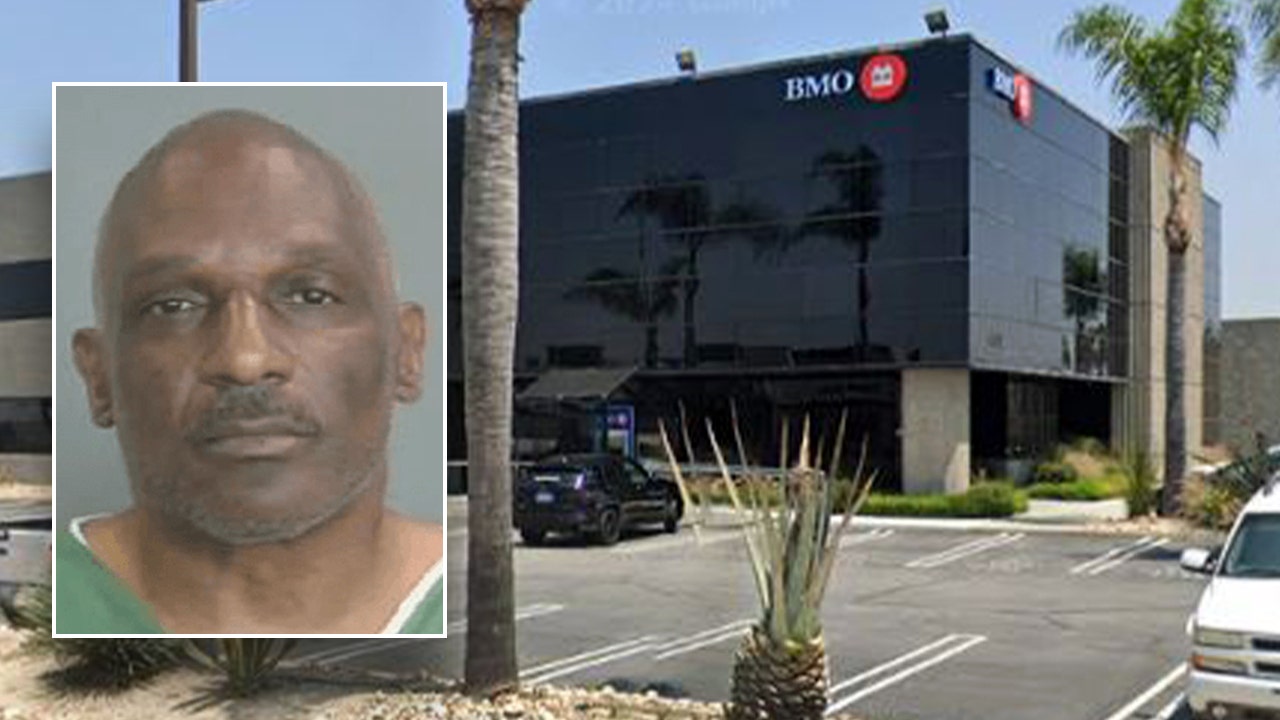
A California man was indicted by a federal grand jury on Wednesday after allegedly taking three people hostage while robbing a bank last month, the Department of Justice announced.
Eric Walter Gray, 53, is facing one count of bank robbery and forced accompaniment after allegedly robbing the BMO bank branch in Anaheim, California, on May 8 – which was one day after he was released from state custody at the San Quentin Rehabilitation Center.
Gray, who had been loitering at the bank for “a long time,” allegedly jumped over the teller counter, stated he had a gun and demanded money, according to an affidavit in support of a criminal complaint filed in the case.
He was given an undisclosed amount of money from the teller drawers, which he then put in his pockets, the DOJ said.
FLORIDA SNIPER SHOOTS, KILLS BANK ROBBER HOLDING HOSTAGES THROUGH COMPUTER MONITOR: VIDEO
Eric Gray, 53, was indicted by a federal jury on Wednesday in connection with the robbery of BMO Bank in Anaheim, California, on May 8. Gray is accused of taking three employees hostage during the incident. (Anaheim Police Department)
After taking the money, Gray allegedly ordered the bank manager and two bank employees into a storage room inside the bank, according to the DOJ. The two employees were ultimately let out of the room, but the manager was held hostage for about an hour.
At least one bank employee was able to contact law enforcement during the robbery and Gray was eventually arrested without incident after exiting the storage room with the bank manager, Anaheim police said at the time.
“One day after his release from prison, this defendant allegedly chose to return to crime by taking three victims hostage while he robbed a bank,” U.S. Attorney Martin Estrada said. “My office will continue its efforts to prosecute and punish violent recidivist criminals who harm our community.”
CALIFORNIA SERIAL BANK ROBBERS BUSTED AFTER 6 HEISTS IN MULTIPLE CITIES, POLICE SAY
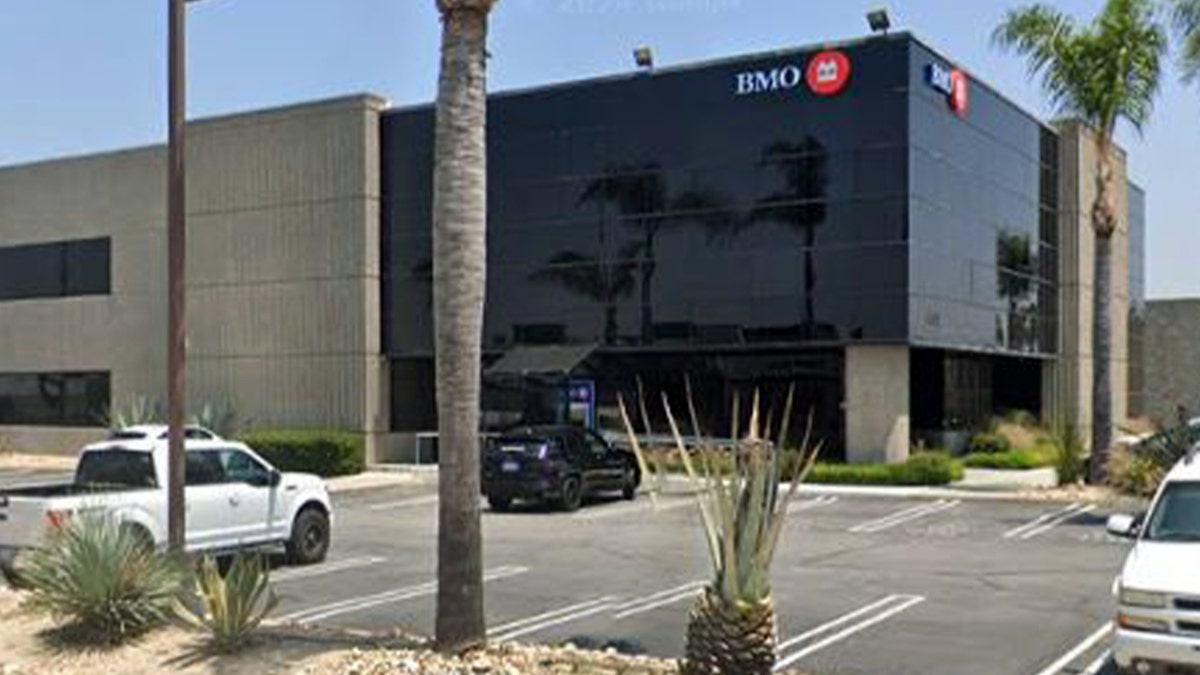
Gray is accused of loitering outside the BMO Bank location in Anaheim, California, for a “long time” before allegedly robbing it on May 8. (Google Earth)
Gray was taken to the hospital for a scan, where he allegedly tried to escape multiple times. He is also accused of fighting with police officers there, which resulted in multiple injuries to the officers involved, according to the DOJ.
Court papers alleged that law enforcement also found cash and narcotics “hidden inside Gray’s body,” the DOJ said in its news release.
“The victims in this case dealt with fear and death threats while the defendant held them hostage until they were rescued, thanks to the courage of bank employees who notified police,” said Krysti Hawkins, the Acting Assistant Director in Charge of the FBI’s Los Angeles Field Office.
Hawkins also said Gray will be held “accountable for his violent actions.”
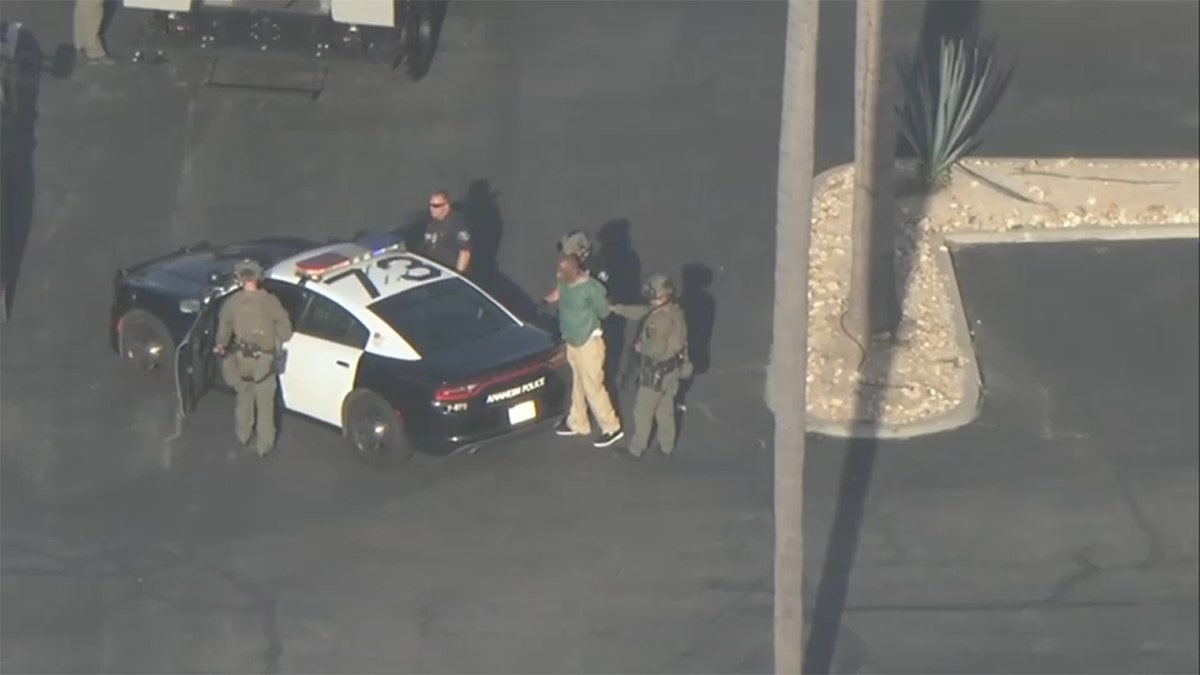
Gray was arrested without incident after exiting BMO Bank with the manager he was allegedly holding hostage in a storage room. (FOX 11 LA)
The Orange County District Attorney’s Office filed charges against Gray in connection with the bank robbery, but dropped them so the federal case against him could move forward.
Gray, who is in jail without bond, will be arraigned in U.S. District Court in Santa Ana on June 24. If convicted, he would face a mandatory minimum sentence of 10 years in federal prison and a maximum sentence of 20 years.
Read the full article from Here

Alaska
Alaska Airlines reaches tentative labour deal with flight attendants union
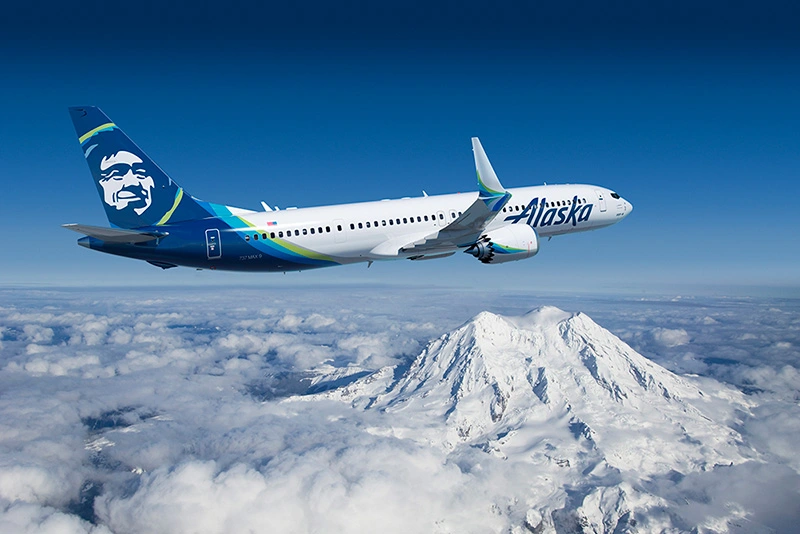
Alaska Airlines and its 7,000-member flight attendants’ union have reached a tentative labour agreement after more than a year and a half of negotiations, reported CNN.
The terms of the deal have not been disclosed, but the union described it as a “record contract.”
It is expected that the agreement includes a significant pay increase, a common demand across the airline industry, especially from unions whose members have not received a pay raise in years.
In April, the union announced to members that it was seeking pay raises of between 43% to 56%, depending on seniority, through 2026. These pay raises would include back pay covering the year and a half during which they have been working under the terms of the previous contract.
The union credited its members’ actions over the past two years of bargaining for ensuring they had the leverage to “extract every last dollar from Alaska Airlines management.”
Alaska Airlines expressed satisfaction with reaching an agreement and thanked the union negotiators. “With our combined efforts, we’ve been able to reach an agreement that provides quality of life and continued career growth at Alaska,” the airline said in a statement. The agreement still requires approval from union leadership and rank-and-file members to be implemented.
In February, union members voted 99.5% in favour of authorising a strike. However, under the Railway Labor Act, which governs airline workers, they could not go on strike despite the contract reaching its scheduled end date in December 2022. As a result, union members continued to work under the terms and pay of the expired contract. These restrictions on striking do not apply to most private sector employees.
In February, flight attendants from Alaska Airlines, along with those from American, United, and Southwest, held unprecedented coordinated pickets to demand new contracts.
Since then, Southwest flight attendants have reached an agreement that included an immediate 22.3% raise as of May 1, and US$364 million in retroactive wages.
Meanwhile, flight attendants at American and United are still negotiating for new deals. American flight attendants have requested to be released from restrictions so they can strike, but even if granted, there would be months of cooling-off periods before they could walk out, as mandated by the Railway Labor Act.
Arizona
Does Arizona have enough water? Phoenix-area cities are spending big to make sure it does

Brett Fleck does not have an easy job. He manages water for a city in the desert. He has to keep taps flowing while facing a complicated equation: The city is growing — attracting big business and thousands of new residents every year — but its main source of water is shrinking.
Standing on the edge of a sun-baked canal with palm trees lining its banks, Fleck watched water flow into the pipes that supply the Phoenix suburb of Peoria, Arizona.
“We’re really having a complete changeover in how people view the Colorado River from a reliability standpoint,” he said.
Get top headlines and KUNC reporting directly to your mailbox each week when you subscribe to In The NoCo.
The river, which accounts for about 60% of the city’s supply, is stretched thin. Its water is used by 40 million people from Wyoming to Mexico. Climate change is shrinking its supply, and the federal government is scrambling to boost depleted reservoirs. The Biden Administration has poured money on the problem, allocating $4 billion from the Inflation Reduction Act for Colorado River projects.
Across the seven U.S. states that use its water, that money has been used to save water in a number of ways — from patching up leaky canals to paying farmers to pause crop planting. A relatively small chunk of that money has gone to cities, but it’s being welcomed with open arms in the Phoenix metro area.
Peoria’s water department is one of seven in Arizona getting paid by the federal government to leave some of its supplies in Lake Mead, the nation’s largest reservoir. In May 2023, the Biden Administration announced it would set aside $157 million for a handful of Arizona cities and one mining company to cut back on their take from the Colorado River.
Following that money and seeing how cities are spending the federal cash reveals a major trend in Arizona’s water management.
The Biden administration framed the spending effort as “water conservation,” but Arizona’s municipal water leaders aren’t using it to make changes traditionally thought of as conservation. Instead of paying for small tweaks to water use – like encouraging residents to install low-flow showerheads or rip out their thirsty lawns – many are thinking bigger, putting their multimillion dollar checks towards billion dollar infrastructure projects that are aimed at keeping taps flowing for decades to come.
Basically, cities like Peoria are planning to engineer their way out of the problem.
“When you don’t have that reliability,” Fleck said, “You have to make additional investments for alternatives, backup supplies, etc. That’s what it really takes to make sense of the world that we live in now.”
A changing mindset
Much ink has been spilled about the future of life in Phoenix. The sprawling metro area – referred to by locals as “The Valley” – is home to about 5 million people. A booming economy and strikingly wide suburban sprawl are pushing its borders further into once-unoccupied dusty expanses in nearly every direction. Meanwhile, climate change has inspired growing skepticism about the long-term sustainability of that growth.
Scorching temperatures, which consistently peak above 110 degrees in the summer, and much-publicized threats to its major sources of water, have accelerated calls in the national media for central Arizona to pump the brakes on expansion.
But on the ground, the people that run water departments in cities and suburbs project optimism.
“We have to plan ahead and say, ‘It’s not enough to have enough water to live this year, this month, two years, or five years,” said Cynthia Campbell, a water management advisor for the City of Phoenix. “We plan for 100, and that’s the way we’ve approached it in Arizona. That, I think, is the secret sauce that keeps us sustainable.”

Campbell described shifting attitudes in Phoenix-area water management. Dwindling water supplies have, for years, forced those cities to do more with less. She explained how Phoenix uses less water now than it did two decades ago, despite significant population growth. The city mostly chalks that up to more efficient water use by homes and businesses, specifically highlighting water that was conserved through more efficient outdoor watering for lawns and plants.
But now, those practices are getting closer to the ceiling in terms of how much water they can save, and new residents keep arriving.
“At some point in time, there does have to be a recognition of the scope of the problem,” Campbell said. “You just can’t conserve your way out of it.”
That mindset has put one word on the lips of many water managers in central Arizona: augmentation.
Engineering a way to more water
The word “augmentation” has different definitions depending on who you ask, but it generally means water departments are focused on adding new water supplies, rather than just using less of the water they already have.
Peoria and Phoenix water leaders highlighted two expensive infrastructure projects that fall into the augmentation category. The first is a massive renovation of a nearby dam that would make its reservoir bigger, allowing cities in the area to store more water during wet winters.
The Bartlett Dam holds back a reservoir about an hour’s drive northeast of Phoenix. Over time, the reservoir has gotten shallower, as sediment in the water settles to the bottom and piles up, reducing the amount of water storage. Bartlett Reservoir and nearby Horseshoe Reservoir have lost a combined 45,000 acre-feet of their total holding capacity. By comparison, Peoria, a city of nearly 200,000 people, gets a total of 35,000 acre-feet of water delivered each year.
Because the reservoirs reach capacity more quickly, water managers have been forced to release excess water instead of storing it for dryer times. A proposed expansion of the dam would make it easier to store that water by making Bartlett Dam about 100 feet taller. Peoria and Phoenix are among 22 cities, tribes and farm districts that are interested in chipping in for the project, which is projected to cost about $1 billion.

Michael McNamara
/
Salt River Project
The dam holds back water from the Salt River, whose supplies are managed separately from the Colorado River. But increasing the amount of stored Salt River water could help cities ease up on their Colorado River reliance.
A second idea that falls into the augmentation category represents an entirely different way of “adding” water to the system, and it’s part of a regional trend: cleaning up sewage and making it drinkable again.
Water managers refer to the practice as “advanced water purification,” or “wastewater recycling,” and it’s stirring up a lot of excitement – and big investment – in a number of places that share similar anxieties about shrinking supplies from the Colorado River.
Small cities are eyeing the expensive new technology for the future, and big ones are already putting shovels in dirt.
In Phoenix, the city council greenlit a $300 million construction project to revive a shuttered water treatment plant in the city’s far northern reaches, which officials said would lay the groundwork for installing equipment to turn wastewater into clean drinking water.
Elsewhere in the Colorado River basin, big cities are forging ahead with the practice. In the Los Angeles Metro area, the main water distributor proposed a $3.4 billion wastewater recycling facility, and has rallied hundreds of millions of dollars in support from out-of-state water agencies that could buy California’s unused Colorado River water if the new facility is a success. In Colorado, the state government passed first-of-its-kind legislation that would make it easier for cities to bring the new water treatment tech online, and some cities say they’re 3-5 years away from building it.
Beneath the surface
Phoenix-area water managers have to keep a lot of balls in the air at once. The water flowing through their pipes comes from a few sources, each with very different challenges.
The Colorado River, which mostly begins as snowmelt in the faraway Rocky Mountains, comes to the metro via the Central Arizona Project, a 336-mile canal that cuts through the desert. The Salt and Verde Rivers bring snow and runoff from a watershed that covers the colder, higher-altitude parts of Arizona. And one source starts much closer to home: groundwater.
That last water source, at least recently, has proven the trickiest to manage. Groundwater use and management have become hot-button political issues in Arizona as experts raise alarm about underground stores of water that are shrinking fast, including some that, once drained, would take generations to refill.
Water experts say all of the most pressing water issues facing Arizona cities – the shrinking Colorado River, the overtaxed underground aquifers, and work to augment existing supplies – are all smaller pieces of a bigger puzzle.
Kathryn Sorensen, a former director of Phoenix’s water department, said Colorado River shortages will probably turn up the pressure on groundwater.
“Our aquifers, while large and plentiful, are also fossil aquifers, so if we pump them out too quickly, then it’s just gone,” said Sorensen, who now researches water policy at Arizona State University. “So these types of things like advanced water purification, augmentation, additional conservation efforts, those all play into avoiding the use of those fossil groundwater supplies.”
Sorensen described the groundwater supplies – and whether or not they’re managed sustainably – as pivotally important to Arizona’s long-term future.
“If we’re going to continue to have the sort of economic opportunities we have here and the quality of life that we have here a few generations from now,” she said, “It’s really of utmost importance that we protect groundwater today.”
‘There’s not a lot of gambling going on here’
Groundwater has become the latest issue to help fuel a wave of national attention on the long-term viability of Phoenix as a place for people to live.
Articles with headlines like “How long can the world’s ‘least sustainable’ city survive?” have helped to crystalize nationwide skepticism about central Arizona’s future. In 2023, state officials put a pause on some new subdivisions because they couldn’t draw enough water from underground. The announcement launched a flurry of news coverage. The New York Times framed it as “the beginning of the end” for development around Phoenix.
In that article, Katie Hobbs, Arizona’s governor, is quoted as saying, “We are not out of water and we will not be running out of water.”

Hobbs and other leaders in the state have been forced into a bit of a juggling act. Some are trying to advocate for policies that respond to the Phoenix area’s water supply crunch while simultaneously trying to tamp down any fears that the city and suburbs might not be a good place to live and work.
Campbell, who advises Phoenix’s political leaders on water decisions, said she’s confident that people who buy a house or open a business in Phoenix will have water in the future, because those policymakers are feeling a lot of pressure to make sure growth is sustainable.
“They know that the moment there’s a crack in the armor,” she said, “The moment that we have to turn off a tap, every national media outlet will cover it, and it will have a devastating effect on our economy. So there’s not a lot of gambling going on here.”
What ‘sustainable’ growth looks like
Sustainable growth certainly weighs on the mind of water manager Brett Fleck in Peoria.
The city itself touted its status as one of the nation’s top “boomtowns,” growing by 19% in the five-year stretch between 2016 and 2021. It recently paved the way for a massive, $2 billion microchip operation. Amkor Technology’s 56-acre facility in Peoria is set to be the nation’s largest semiconductor packaging and test facility, and will likely use a massive amount of water.
“Do I think Arizona can continue to grow sustainably? As long as we continue to make the investments and plan, absolutely,” he said. “The day that we stop making those investments in our sustainability is the day that we probably shouldn’t be growing anymore.”
Fleck said his city is working with Amkor to create a system that brings recycled water to the facility, so the semiconductor operation doesn’t draw from the drinking supply.

At a relatively small water treatment plant on Peoria’s western edge, the city’s water system is getting upgraded in real time and the facility is quickly expanding its footprint.
“This water reclamation facility is really the start of Peoria’s water future,” Fleck said as workers in hard hats crisscrossed the dirt expanse behind him.
Treated water from the plant could see a few fates, Fleck said. It may be pumped into underground storage, sent to the giant new microchip facility, or maybe even purified to drinking standards and sent back into pipes. The latter is probably a decade from reality.
“It’s all based on funding,” Fleck said.
Now that cities around Arizona are seeing the promise of new technology and methods to get more out of their endangered water supplies, the massive cost of those projects stands as the biggest hurdle to their implementation. Fleck said the billions of federal dollars being sent to remedy the Southwest’s water woes pale in comparison to the tens or hundreds of billions needed to build needed infrastructure.
“Unfortunately, it’s a drop in the bucket,” he said. “However, at least we’re headed in the right direction. So at least we’re making those investments, and we’re recognizing that we need to make those investments to pivot away from our very large reliance on Colorado River supplies.”
Armed with a combination of federal, state, and local money, cities all around the Phoenix area are moving in that direction. Tempe, for example, has similar plans to Peoria and plans to open a water recycling facility by 2025. Nearby Scottsdale hosts one of only three water treatment facilities in the nation that is part of a pilot program for advanced water purification, and is poised to bring it into regular use.
An uncertain future
Arizona’s city leaders say they’re doing all they can to fend off anxiety about an uncertain future for water supply. Two big factors, largely out of those cities’ hands, mean that anxiety is justified.
The first is funding. Large-scale, high-tech water projects that come with nine- or ten-figure price tags benefit greatly from federal help. The Biden Administration has spent an amount of money that one water expert called, “the largest investment in drinking water infrastructure and water supply infrastructure that we’ve seen in a generation.”
Future administrations might not be so spendy.
“Federal funding is always a dicey proposition,” said Sorensen, the ASU water researcher. “Relying on annual appropriations, it can be hinky, especially when you have to compete with other very worthy federal priorities.”
The second big cause for uncertainty is the messy, ongoing negotiation process that will result in new rules for sharing the Colorado River. The current rules for divvying up its water expire in 2026, and the people in charge of writing new ones are stuck in a heated standoff.
Those people are negotiators from the seven states that use its water. Despite their differences, they generally agree that climate change has shrunk the amount of water in the river, and states need to cut back on demand accordingly.

Their disagreements, though – sometimes rooted in century-old rivalries between states – mean that it’s not clear exactly how much water, if any, each state should lose.
But every proposed cutback plan, even the one co-signed by Arizona itself, puts more of Arizona’s water on the chopping block than any other state.
That is due to a system called prior appropriation, which serves as the bedrock of Colorado River management. In short, it means that the first person to use water will be the last to lose it in times of shortage. And when it comes to Colorado River use, Arizona sits in a more vulnerable legal position.
The canal that carries water to central Arizona from the Colorado river was authorized in 1968, and the users who depend on its water are first in line to have their water taken away when reservoirs are low.
Sorensen said that fact is a major motivator for Arizona’s water leaders to make sure they manage supplies in a sustainable way.
“We’ve known since 1968 that our water was first to be cut when there wasn’t enough to go around, and that has made us prepare very methodically for those cuts,” Sorensen said. “The pressure has certainly been turned up, but it’s pressure that’s always existed.”
This story is part of ongoing coverage of the Colorado River, produced by KUNC and supported by the Walton Family Foundation. It was produced in partnership with The Water Desk, an independent initiative of the University of Colorado Boulder’s Center for Environmental Journalism.
California
California man on three-hour hike rescued after being lost for 10 days

A Californian man who embarked on a three-hour hike has been found after being stranded for 10 days in the mountains, surviving mostly off water.
Lukas McClish, 34, covered in dirt, reunited with his family late last week afer his ordeal in the Santa Cruz Mountains.
McClish told KGO that he set out on a hike on June 11 from his hometown of Boulder Creek in what he thought would be a short outing that Tuesday on his way to work; however, the further he got into the hike he became lost after he did not recognize several guiding landmarks that had been burned down in wildfires.
McClish, a hiker and experienced backpacker who does landscaping in forests that have been destroyed by wildfires, told The New York Times that he was intending to go and look at a granite outcropping in a nearby woods, but ended up becoming lost in the area that was devastated by the CZU Lightning Complex fire in 2020.
“That’s one thing that I didn’t take into consideration — when the fire comes through like that and decimates it, it turns into the desert, and you’re unable to find your bearings,” he told the outlet.
On June 16, McClish was supposed to attend a Father’s Day dinner with his family, but after becoming a no-show, he was declared missing that day once they had alerted authorities.
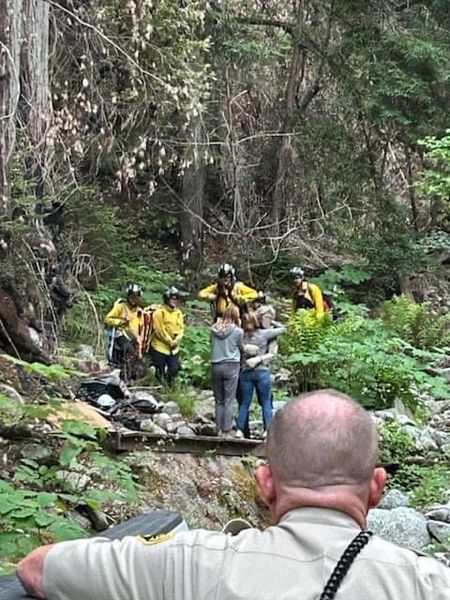
Four days later, McClish was found after multiple reports came into local agencies that they could hear the sound of someone yelling for help in the Big Basin Redwoods State Park.
“Just help, help. I’m over here. Or is anybody out there? I want a burrito and a taco bowl, that’s what I thought about every day when after the first five days, when I started to kind of realize that I might be in over my head,” McClish told KSBW.
Around 3pm in the afternoon, several witnesses reported hearing someone yelling for help in Foreman Creek off Big Basin Highway, the Santa Cruz County Sheriff’s Office wrote in a social media post.

The deputies from the sheriff’s office, State Parks, Cal Fire and Boulder Creek Fire Department all responded to the area, where they eventually found McClish, who had been missing for around 10 days at that point.
The agencies used drones to find McClish’s exact location, and State Park rangers were shortly on scene with the missing man, with fire crews behind them to bring him to safety.
Fortunately, the hiker had no major injuries and was able to reunite with his family, the sheriff’s office wrote.
The hiker told KGO that he was overwhelmed by the amount of personnel that joined in his rescue.
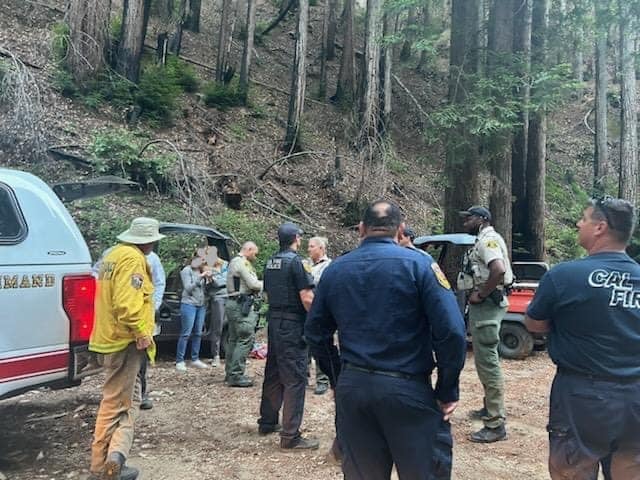
“It was just really humbling and I don’t know, it was an awesome experience,” McClish said.
“I left with just a pair of pants, and my pair of hiking shoes, and a hat. I had a flashlight, and a pair of folding scissors, like a Leatherman tool. And that was about it,” McClish added.
While he was lost in the Big Basin State Parks area, McClish told the outlet he managed to survive by drinking lots of water.
“I just make sure I drank a gallon of water every day, but then after, getting close to the end of it, my body needed food and some kind of sustenance,” McClish said.
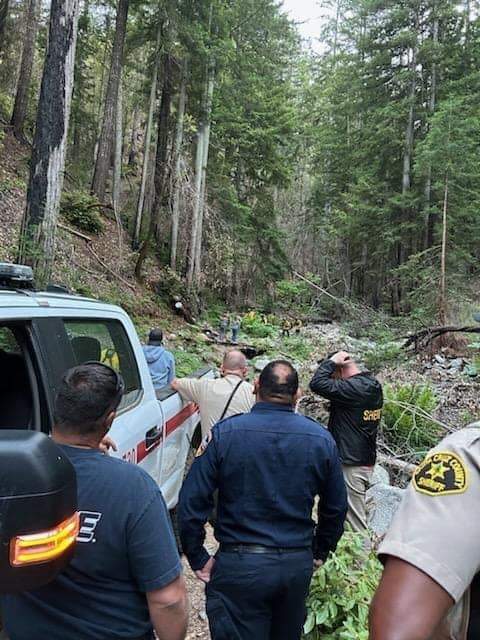
He told KSBW that on the days he was out in the wilderness, he just kept hiking, going up and down canyons, and even encountered a mountain lion while trying to find his way out.
“I felt comfortable the whole time I was out there; I wasn’t worried,” McClish, who has backpacked through other regions in the US, told the outlet. “I had a mountain lion that was following me, and it was cool. It kept its distance. I think it was just somebody watching over me.”
McClish, who likes to “embrace the wilderness,” used the opportunity to test his survival skills while he was lost; however, the hiker ended up losing around 30 pounds in 10 days, the New York Times reported.
Now he has been rescued, he told KGO that he thinks he has done “enough hiking for probably the whole rest of the year.”
-
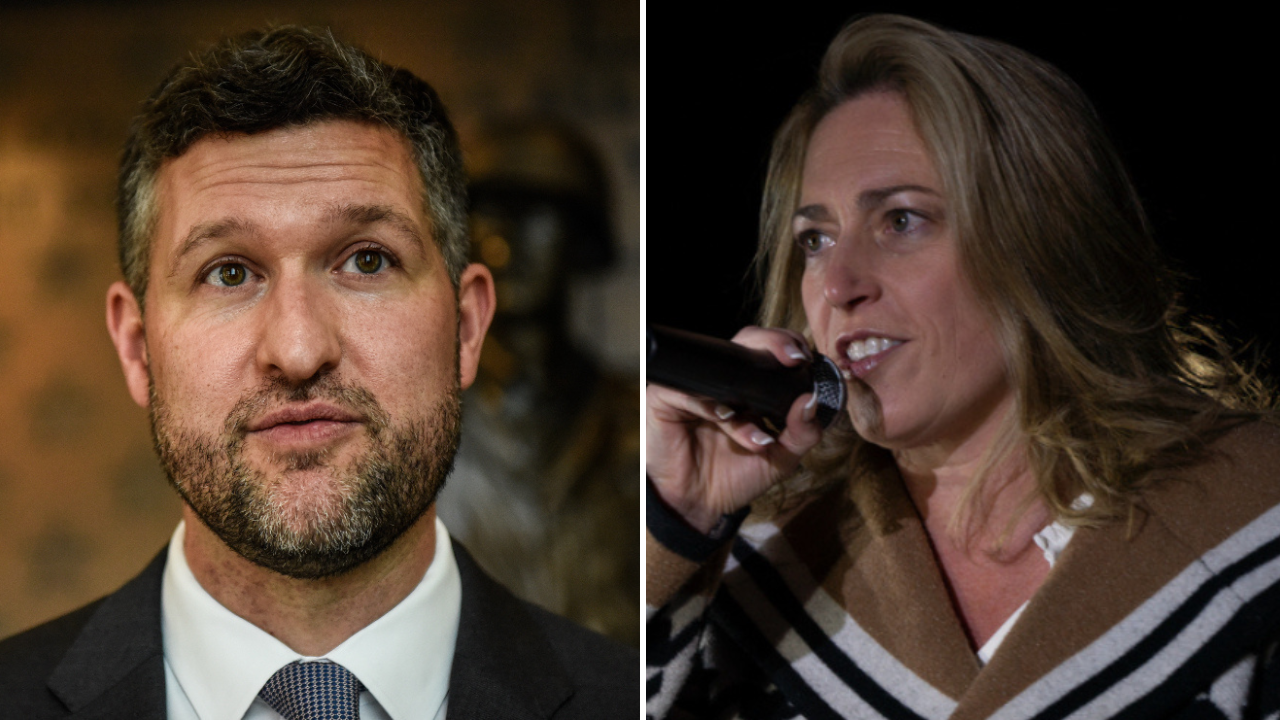
 Politics1 week ago
Politics1 week agoRule of law on ballot in NYC suburbs as cop, veteran trade barbs over border crisis, policing
-

 News1 week ago
News1 week agoIt's easy to believe young voters could back Trump at young conservative conference
-

 World1 week ago
World1 week agoSwiss summit demands 'territorial integrity' of Ukraine
-

 News1 week ago
News1 week agoJustice Department won't pursue contempt charges against Garland
-

 World1 week ago
World1 week agoSwitzerland's massive security effort at the Ukraine peace conference
-

 Politics1 week ago
Politics1 week agoBiden looks to capitalize on star-studded Hollywood fundraiser after Trump's massive cash haul in blue state
-

 News1 week ago
News1 week agoJoe Biden, Barack Obama And Jimmy Kimmel Warn Of Another Donald Trump Term; Star-Filled L.A. Fundraiser Expected To Raise At Least $30 Million — Update
-

 Politics1 week ago
Politics1 week agoJudge rules Missouri abortion ban did not aim to impose lawmakers' religious views on others














